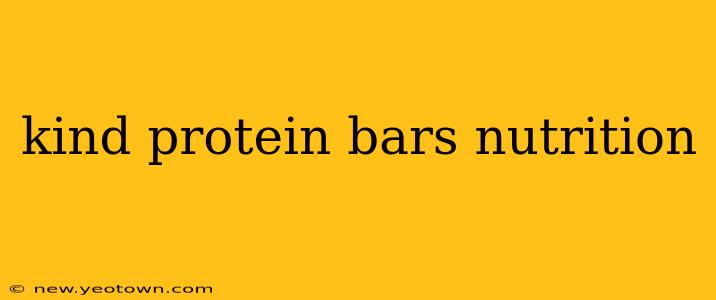Kind protein bars have become a staple for many health-conscious individuals seeking a convenient and satisfying snack or meal replacement. But are they truly as nutritious as they claim? Let's delve into the nutritional aspects of these popular bars, examining their ingredients, benefits, and potential drawbacks to help you determine if they fit into your healthy eating plan.
My name is Sarah, and I've been a registered dietitian for over 10 years. I've helped countless clients navigate the often-confusing world of nutrition labels and find foods that align with their health goals. Today, we'll be exploring the nutritional landscape of Kind protein bars together.
What are Kind Protein Bars Made Of?
The ingredient list varies slightly depending on the specific flavor, but generally, Kind protein bars boast a blend of whole nuts, seeds, and dried fruits. This forms the base of the bar, providing a good source of fiber, healthy fats, and natural sugars. The protein content comes from a variety of sources, often including whey protein, soy protein isolate, or pea protein. Many varieties also contain added sweeteners like honey or agave nectar, and some might include chocolate chips or other additions. It's always crucial to check the specific nutrition label of the bar you're considering.
How Much Protein is in a Kind Protein Bar?
This is a question many people have! The protein content typically ranges from 10 to 14 grams per bar, depending on the flavor and size. This makes them a decent source of protein for a snack, but it's important to remember that this will vary based on your individual protein requirements.
Are Kind Protein Bars Healthy?
The "healthy" label is subjective. Kind bars can be part of a balanced diet, offering a good source of protein, fiber, and healthy fats. The fiber content aids in digestion and can help you feel full and satisfied, which is beneficial for weight management. However, the added sugars and relatively high calorie count mean moderation is key.
What are the Benefits of Eating Kind Protein Bars?
- Convenient: They're perfect for on-the-go snacking, offering a quick and easy way to boost protein and fiber intake.
- Portable: Easy to pack in a lunch bag or purse.
- Source of Protein: They provide a decent amount of protein, contributing to muscle growth and repair.
- Fiber Rich: The high fiber content aids in digestion and promotes satiety.
- Variety of Flavors: There's a wide range of flavors available, making it easier to find something you enjoy.
What are the Drawbacks of Eating Kind Protein Bars?
- High in Calories: They can be calorie-dense, so mindful consumption is important if you're watching your weight.
- Added Sugar: While some sugars come from natural sources, added sugars are present in many flavors and should be considered.
- Price: Kind bars are typically more expensive than other protein bars on the market.
- Potential Allergens: They contain nuts and other potential allergens, so those with allergies should check the ingredient list carefully.
Are Kind Protein Bars Good for Weight Loss?
Kind bars can be incorporated into a weight loss plan, but they aren't a magic bullet. The high calorie and sugar content mean portion control is crucial. They can be a helpful tool for managing hunger between meals, but they shouldn't replace whole, unprocessed foods as the foundation of your diet.
Are Kind Protein Bars Gluten-Free?
Many Kind bars are certified gluten-free, but it's always essential to check the specific product label to confirm. Always look for the gluten-free certification seal.
How Many Kind Protein Bars Should I Eat Per Day?
There's no one-size-fits-all answer. The appropriate number of Kind bars depends on your individual calorie needs, activity level, and overall dietary goals. It's best to consult with a registered dietitian or healthcare professional to determine the right amount for you.
In conclusion, Kind protein bars can be a valuable addition to a balanced diet, offering convenience and nutritional benefits. However, mindful consumption, considering the calorie and sugar content, and checking for allergens, is essential. As always, a well-rounded diet that emphasizes whole, unprocessed foods should remain the cornerstone of your healthy eating plan.

